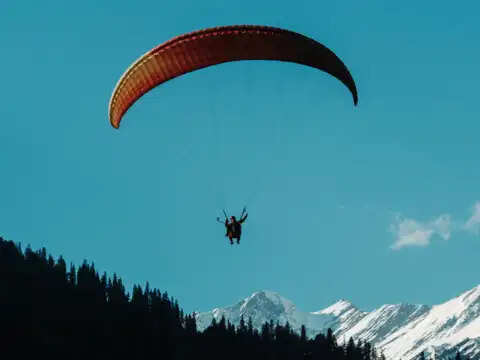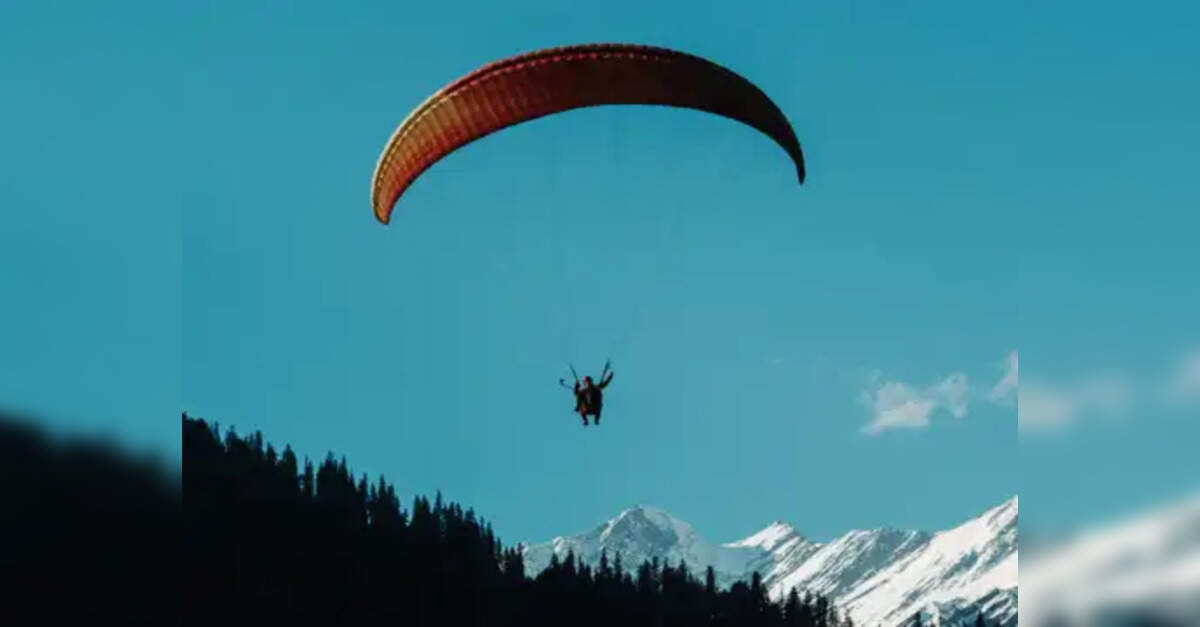 Thrill or threat? India’s booming adventure tourism faces deadly safety gaps
Thrill or threat? India’s booming adventure tourism faces deadly safety gapsAt Keri village in Goa, a Pune resident strapped in for what was meant to be a bucket listticking flight on a paraglider in January. Minutes later, she and her Nepalese instructor plunged into a ravine after a rope snapped midair. Both were killed.
In the past year alone, paragliding has claimed seven lives in Kullu and Kangra, with three fatalities occurring in a single month. Over the past five years, Himachal Pradesh has reported around 30 deaths from paragliding accidents, and Bir-Billing leads in the count of these tragedies, often due to unlicensed pilots or faulty gear.
In Manali, a 12-year-old girl recently fell 30 feet from a zipline.
In Bhunter, Himachal Pradesh, a Malayali tourist died when an overloaded raft capsized. The operator had no valid licence.
Stories like these are becoming alarmingly routine. From rafting accidents in Rishikesh to undertrained instructors leading high-altitude treks in the Himalayas, India is grappling with a safety crisis in adventure sports.
This is happening just as the market has surged post-pandemic, according to the Adventure Tour Operators Association of India (ATOAI). The adventure tourism market, worth USD 16.7 billion in 2024, is projected to quintuple to USD 86 billion by 2033, growing at 17.8 per cent annually, according to IMARC Group, a consultancy.
While money and demand are soaring, the guardrails—in terms of training, equipment and enforcement of regulations—are often dangerously absent. How much more blood needs to be spilled, before things change?
SAFETY GAP
The Union ministry of tourism offers guidelines for operators to register activities such as trekking, mountaineering, rafting and aero sports, but adherence is voluntary. “There is no mandatory licensing system in India. Anyone can register a company and start promoting adventure travel,” says
Arshdeep Anand, vice-president, ATOAI. That allows unrecognised operators to enter the market without meeting even basic safety norms.
In Maharashtra, unregulated ziplining and rappelling have sprung up at forts and waterfalls like Harihar, Duke’s Nose and Kalu Waterfall without government approval, raising alarm among forest and tourism officials. These are marketed as safe and family-friendly—until something goes wrong.
In paragliding hubs like Bir, the problem begins at the licensing stage itself. “Himachal Tourism grants licences, but officials themselves do not understand the prerequisites,” says Manjeet Thakur, founding member, Billing Paragliding Association.
The lack of a technical body to evaluate instructors means quality varies wildly between operators. Inconsistency plagues licensing in other adventure sports as well. Rakesh Singh Rawat of AdventX, which runs tethered hot-air balloon rides in the Corbett National Park, says there are no guidelines for tethered ballooning by appropriate authorities.
In such cases, safety standards are left entirely to an operator’s discretion.
The most dangerous risk emanates from the person strapping you into a harness. As per guidelines, instructors should have activity-specific certifications from institutes like the Nehru Institute of Mountaineering (NIM) or the Indian Institute of Skiing and Mountaineering (IISM), along with training in first aid and rescue techniques.
But in much of India, these remain aspirations.
TOO GOOD TO BE TRUE
Earlier this year, in Rishikesh, this reporter walked into a rafting shack near Shivpuri and negotiated with an operator. The deal? A full raft for Rs 3,000, less than half the going rate of Rs 1,500-2,000 per person, charged by most licensed companies. The life jackets didn’t fit properly: some hung loose around the chest, others cinched so tight they were hard to breathe in. On the Ganga, where even seasoned rafters can be swept under in seconds, an ill-fitting jacket is a gamble not worth taking.
In Dhikuli, Uttarakhand, hot-air balloon rides were being sold for ?1,199 per person or ?3,999 for couples, with two-three passengers and one pilot squeezed into a small basket rising 200-250 feet.
Just metres away, the same operator sold river rafting packages and oversaw a children’s “playzone” — a climbing wall with flaking paint, an obstacle course with fraying ropes and a tyre swing creaking in the breeze. A one-stop adventure shop, with no sign of specialist training or safety checks.
It is only when things go wrong that people sit up and worry.
In July, Satish Rajeshbhai, a 25-year-old tourist from Ahmedabad, died when his tandem glider failed to lift from Dharamshala’s Indrunag. The pilot, badly injured, survived. Authorities confirmed the launch pad was unauthorised, prompting district authorities to impose a ban on paragliding until September 15, while investigations continue.
In a market where tourists bargain hard and aggregator portals promote the cheapest deals, the temptation to cut corners is constant.
Many tourists don’t see the hidden costs of a “throwaway deal”. Bargain-seekers may get to raft for ?500 less but that discount might come from replacing ropes approved by the International Climbing and Mountaineering Federation (UIAA) with no-name imports, or swapping a certified guide in favour of a trainee paid by the day.
“Safety is paramount,” says Pranav Kukreti of Delhi-based Treks ’n Rapids. “But this may start with not bowing down to competition, commercial pressures, or haggling customers, at the cost of safety.”
Even big-ticket activities are undercut. Rawat says, “Offering a high-cost and highrisk activity like ballooning at a very low cost will only compromise safety”. An experienced pilot costs ?45,000-75,000 a month, but many operators prefer cheaper, less-qualified staff — especially when the sport is seasonal and the balloon sits idle for months.
Taxes add another twist. With a GST of 18 per cent , the margins are thin. For some, that incentivises the informal sector, where bills go unprinted, gear goes unchecked, and the risk is quietly passed on to the customer.
The result: a few operators spend on training, audits and equipment logs while others gamble with lives to stay in the game.
THE HUMAN AND THE GEAR
A common thread in many accidents is human error: undertrained or uncertified operators taking liberties with lives. “Paragliding training requires two years with 150 hours in the air, which can cost ?4-5 lakh,” says Thakur. “But many are taking monthly training for just Rs 15,000-20,000 and joining operator companies with very basic flight experience and no knowledge of dealing with emergency situations.”
Vinod Jacob, MD of Munnar Adventures, a Kerala-based adventure sports operator, says the bar must be set high: “We require instructors with advanced mountaineering certificates (AMC) and a minimum of three years’ experience before they lead any activity. Many rely on short-term local courses that are not recognised.”
Sanjay Rao of Fly Nirvana, a paragliding school in Maharashtra, says, “Our beginner course covers ground handling, classroom sessions, simulator training and supervised solo flights. No one goes off a hill without completing every stage safely.” patience and respect for the elements”.
Then there is the gear. In sports where a single rope, harness, or wing can decide life or death, the difference between certified gear and cheap knockoffs is existential.
Kukreti says, “Buying unbranded imported Chinese gear devoid of certification is a no-no.”
Many operators use second-hand or uncertified gear, often imported from Nepal and Australia, among others. “The standards of Nepal adventure sports gear are similar to European standards. India has no such standard,” says Thakur. The gear may have been safe originally, but years of reuse can turn it into a liability.
Munnar Adventures checks every helmet, harness, pulley and carabiner before use and keeps a written inspection report signed off by a team leader.
Skyhigh India, the country’s only skydiving dropzone accredited to the United States Parachute Association (USPA), maintains its parachutes as per international protocols, sourcing equipment from the US, says Rudra Bhanu Solanki, founder of Skyhigh India. “The instructors have minimum 2,500 jumps each to their name, and our ground crew is trained in jump coordination, aircraft safety and emergency procedures,” adds Solanki.
As Kukreti puts it bluntly: “Adventure sports are not selfie activities. It can be a matter of life and death. You get what you pay for.”
The absence of a uniform, enforceable regulatory framework is what ATOAI has been lobbying to fix, pushing for a model law for adventure tourism, at par with international standards.
In New Zealand, every bungee cord and raft is logged, tested and re-tested under the government’s Adventure Activities Regulations. In Interlaken, Switzerland, paragliding pilots cannot fly commercially without federal licence and insurance.
In Chamonix, France, Europe’s mountaineering mecca, guides must train for years at École Nationale de Ski et d’Alpinisme (ENSA) before leading even a beginner up a glacier. In Whistler, Canada, operators are audited annually, and face hefty penalties if gear inspections are not documented to the last carabiner. Even Dubai’s desert safaris have strict driver licensing and vehicle safety checks.
Adventure sports will never be risk-free, but in India, the line between thrill and threat often comes down to the choices tourists make before strapping in.
For now, the burden, unfair as it may be, is on the thrill-seeker to ask the right questions:
- Is the operator recognised by authorities?
- Are instructors certified by reputed bodies, with verifiable hours of experience?
- Does the gear carry certified markings of UIAA, CE or Bureau of Indian Standards (BIS), and when was it last inspected?
- Are there safety briefings before every activity?
Anand of ATOAI says the next step should be the model law for adventure tourism, making licensing mandatory, standardising safety gear and setting minimum qualifications for instructors. Jacob of Munnar Adventures also calls for “random inspections, mandatory incident reporting and compulsory daily safety logs”.
In adventure sports, the real risk isn’t in the free fall, it is in the blind leap of faith before it.
Check the Red Flags
- ROCK-BOTTOM DEAL: If the price is too good to be true, it probably is
- NO PROOF OF TRAINING: Your guide should have logged hours and got certification from reputed bodies like NIM, IISM, USPA. If they dodge the question on qualification, walk away.
- SHABBY, MISMATCHED GEAR: Look for UIAA, CE, or BIS marks on helmets, harnesses, life jackets and ropes. Avoid operators using faded, ill-fitting, or clearly second-hand gear.
- NO SAFETY BRIEFING: If you are rushed to a raft or a glider without a pre-activity safety demo, instructions, or fitting check, turn away
- MISSING LICENCES OR INSURANCE: Ask if the operator is recognised by the ministry of tourism/state authority and if the activity is insured. If not, you are on your own in case of an accident.
- JACK-OF-ALL-TRADES SET-UP: Operators who sell rafting, ziplines, and hot-air balloons all at once may be spreading the staff thin, with no specialists ensuring safety. Doublecheck everything.



